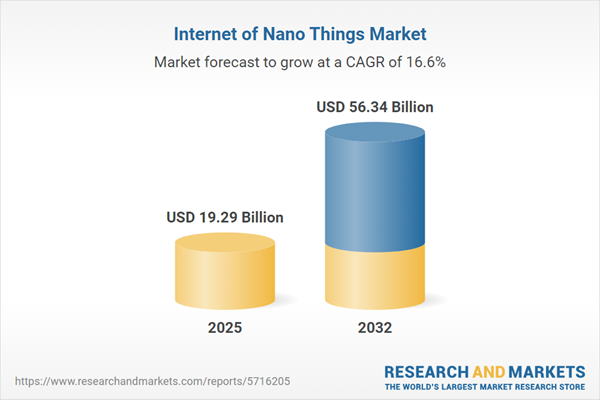Speak directly to the analyst to clarify any post sales queries you may have.
The Internet of Nano Things market is redefining enterprise connectivity, offering leaders a new level of operational precision through advanced device integration and real-time data generation. Forward-thinking organizations are increasingly leveraging IoNT to streamline processes, improve outcomes, and respond rapidly to shifting business environments.
Market Snapshot: Internet of Nano Things Market Size & Growth Trajectory
The global Internet of Nano Things (IoNT) market is on a strong upward trajectory, with total value projected to rise from USD 16.52 billion in 2024 to USD 19.29 billion in 2025. This expansion, marked by a compound annual growth rate (CAGR) of 16.57%, is driven by significant advancements in nanofabrication. These technological improvements are enabling broad adoption in industries where reliability, efficiency, and automated intelligence deliver critical advantage. Sectors such as healthcare and manufacturing are now fully integrating IoNT into core operations, shifting beyond trials to achieve tangible performance gains. Investment in IoNT technology remains robust, reinforced by a heightened focus on innovation and competitive differentiation as organizations strive to adapt to evolving market demands.
Scope & Segmentation: Key Dynamics of the IoNT Ecosystem
This report offers structured insight for senior decision-makers, with detailed segmentation highlighting the Internet of Nano Things market’s strategic components and sector applications:
- Application: Involves areas such as consumer electronics, smart home automation, medical wearables, advanced energy management, environmental monitoring, air and water quality control, clinical diagnostics, personalized medicine, predictive maintenance, and automated manufacturing. Each application enables tailored resource usage and performance improvements in medical and industrial contexts.
- Component: Includes nanoactuators, nanosensors, nanorobots, and nanoprocessors. Key services cover consulting, integration, device maintenance, analytics, and cybersecurity, ensuring enterprise deployments are both scalable and secure.
- End User: Spans agriculture using field sensors, defense employing advanced surveillance, automotive, electronics, pharmaceutical, and food production. Urban hubs increasingly implement IoNT in smart city initiatives to enhance public safety, mobility, and resilience.
- Communication Technology: Uses acoustic, electromagnetic (including optical and terahertz technologies), and molecular communication protocols. These enable secure device interconnectivity, reliable data exchange, and robust system performance in high-demand environments.
- Deployment Mode: Covers stationary, mobile, and wearable options, offering flexibility for both centralized and distributed enterprise networks as well as remote site integration.
- Region: Provides analytics across the Americas, Europe, Middle East & Africa, and Asia-Pacific. Regional adoption is influenced by regulatory standards, local innovation capacity, and market drivers.
- Key Players: Features IBM Corporation, Cisco Systems, Intel Corporation, Qualcomm, NXP Semiconductors, STMicroelectronics, Analog Devices, Microchip Technology, Nanosys, and Nano Dimension, reflecting the influence of leaders shaping industry standards and deployment models.
Key Takeaways for Senior Decision-Makers
- IoNT delivers agile, real-time insight for senior leaders, supporting immediate response to operational changes and fluctuating market conditions.
- Comprehensive data streams from IoNT deployments support transparency, informed enterprise management, and targeted process optimization.
- Flexible system design allows organizations to adjust to new regulatory frameworks and compliance challenges, ensuring business continuity and minimizing risk.
- Cross-industry collaboration with technology vendors, research entities, and regulators is establishing consistent standards and boosting sector-wide governance.
- Regional customization of IoNT strategies enables effective management of supply chains, compliance requirements, and localized challenges in diverse industries.
Tariff Impact: United States Market and Supply Chain Shifts
Recent changes in U.S. tariff structures are driving organizations to modify their IoNT supply chains, focusing on domestic sourcing and supplier diversification. These measures are designed to mitigate exposure to price volatility and potential disruptions. Strengthened contingency planning and compliance oversight have become essential for sustaining operational reliability and meeting regulatory standards.
Methodology & Data Sources
This analysis integrates peer-reviewed literature, patent evaluations, expert opinion, and broad-based market modeling. By drawing from a mix of scientific and industry sources, the report delivers balanced, evidence-based guidance on IoNT adoption impacts.
Why This Report Matters
- Enables senior decision-makers to identify new opportunities and proactively manage risks associated with IoNT evolution.
- Offers clear, actionable insights for technology, compliance, and operational leaders tasked with integrating IoNT in complex regulatory environments.
- Supports investment and strategic planning with benchmarked recommendations that connect technology adoption to core business priorities.
Conclusion
By integrating the Internet of Nano Things, organizations maximize innovation and build business agility. Staying ahead of evolving regulations and technology trends is essential for achieving long-term operational success and competitive positioning.
Additional Product Information:
- Purchase of this report includes 1 year online access with quarterly updates.
- This report can be updated on request. Please contact our Customer Experience team using the Ask a Question widget on our website.
Table of Contents
3. Executive Summary
4. Market Overview
7. Cumulative Impact of Artificial Intelligence 2025
Companies Mentioned
The companies profiled in this Internet of Nano Things market report include:- IBM Corporation
- Cisco Systems, Inc.
- Intel Corporation
- Qualcomm Incorporated
- NXP Semiconductors N.V.
- STMicroelectronics N.V.
- Analog Devices, Inc.
- Microchip Technology Incorporated
- Nanosys, Inc.
- Nano Dimension Ltd.
Table Information
| Report Attribute | Details |
|---|---|
| No. of Pages | 185 |
| Published | October 2025 |
| Forecast Period | 2025 - 2032 |
| Estimated Market Value ( USD | $ 19.29 Billion |
| Forecasted Market Value ( USD | $ 56.34 Billion |
| Compound Annual Growth Rate | 16.5% |
| Regions Covered | Global |
| No. of Companies Mentioned | 11 |









